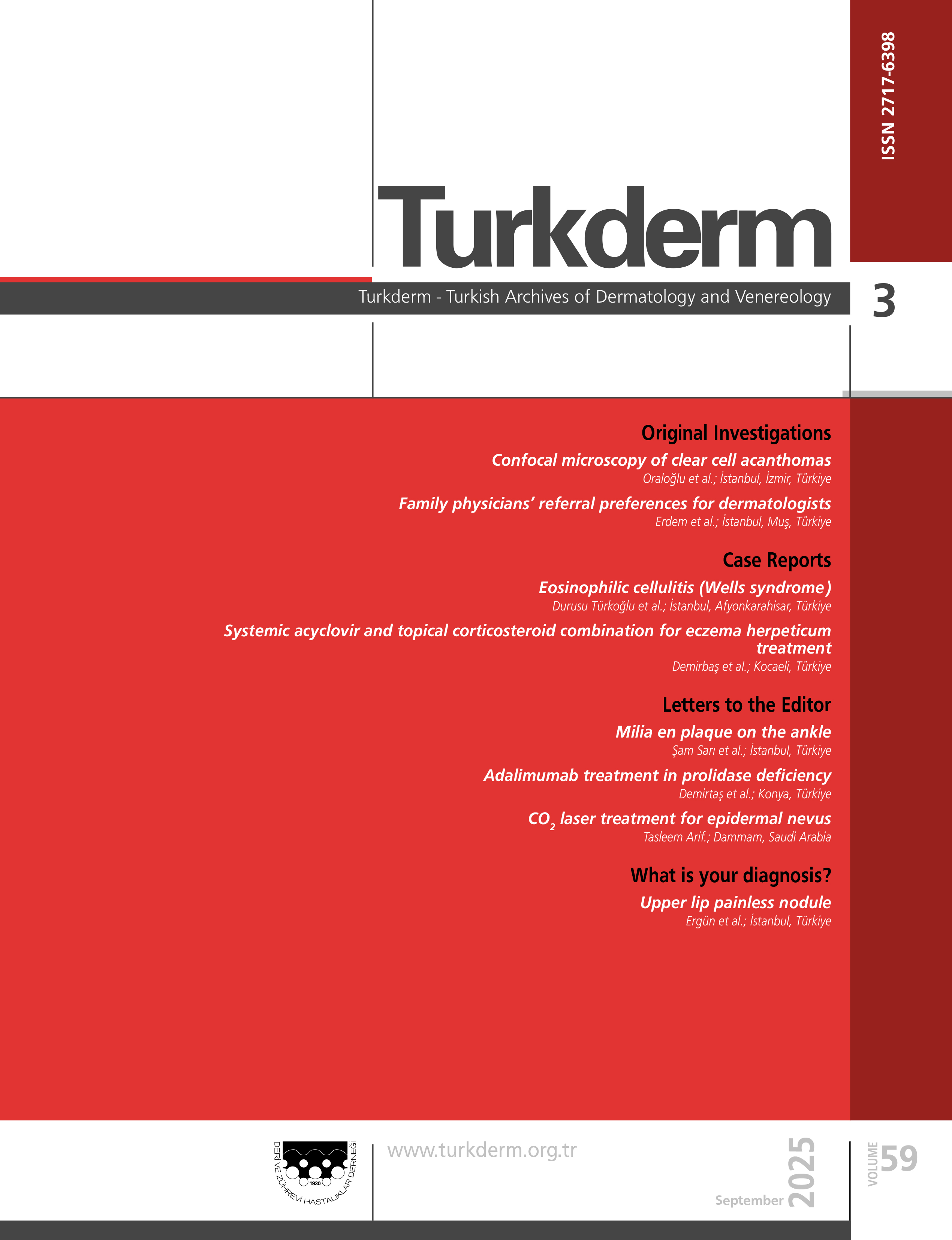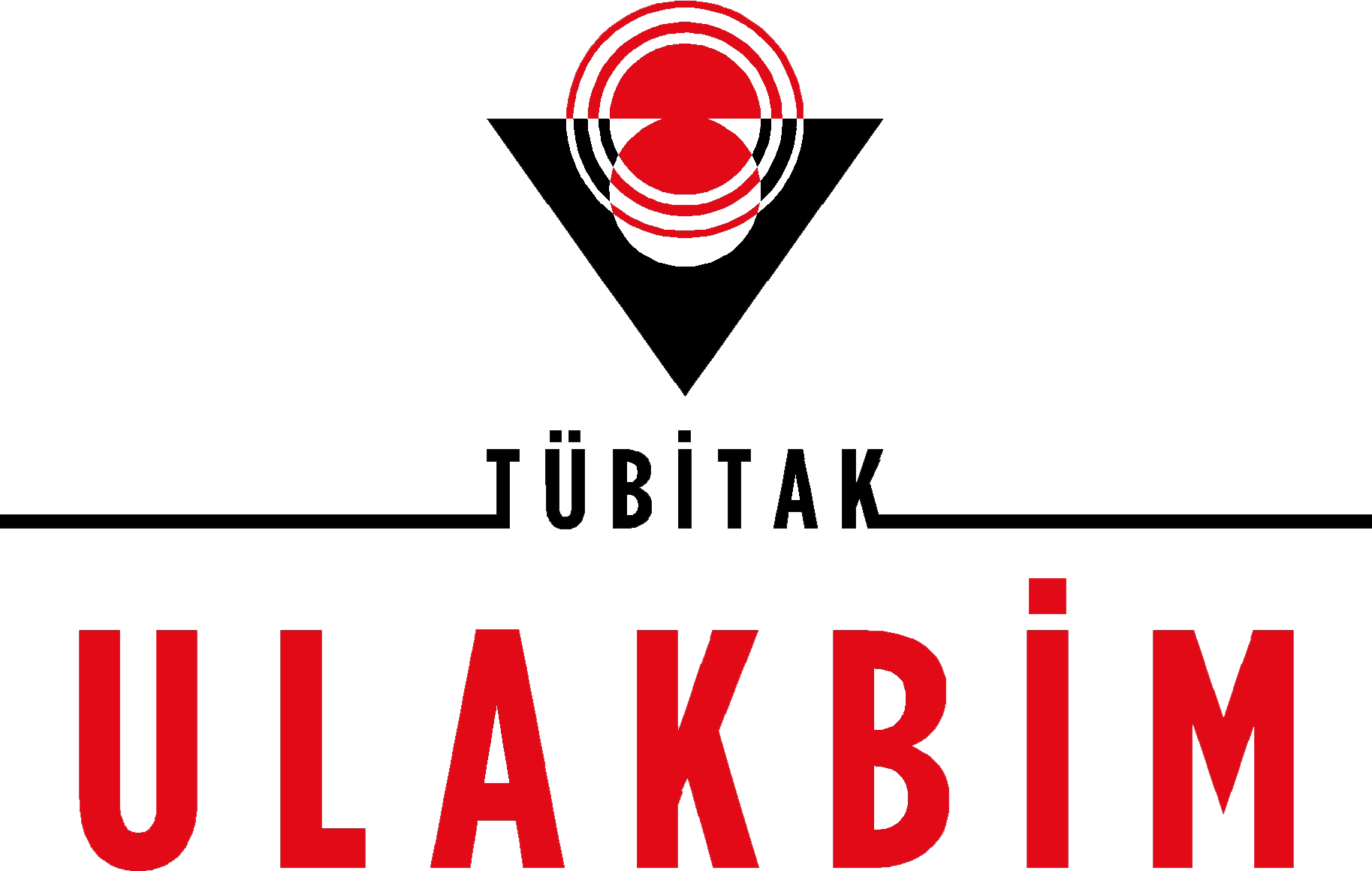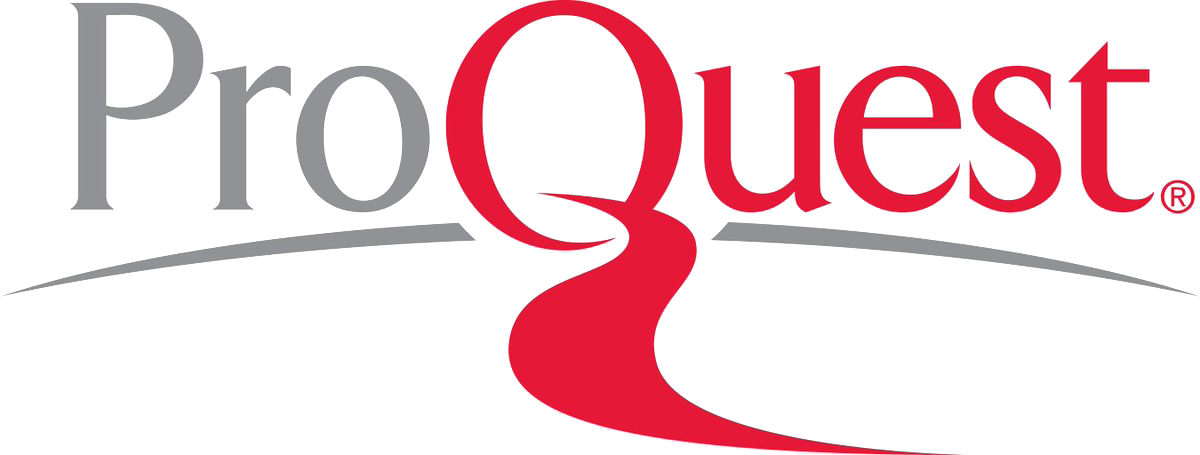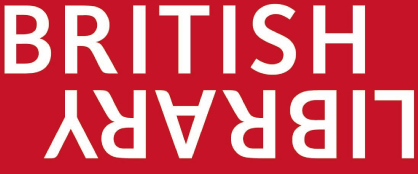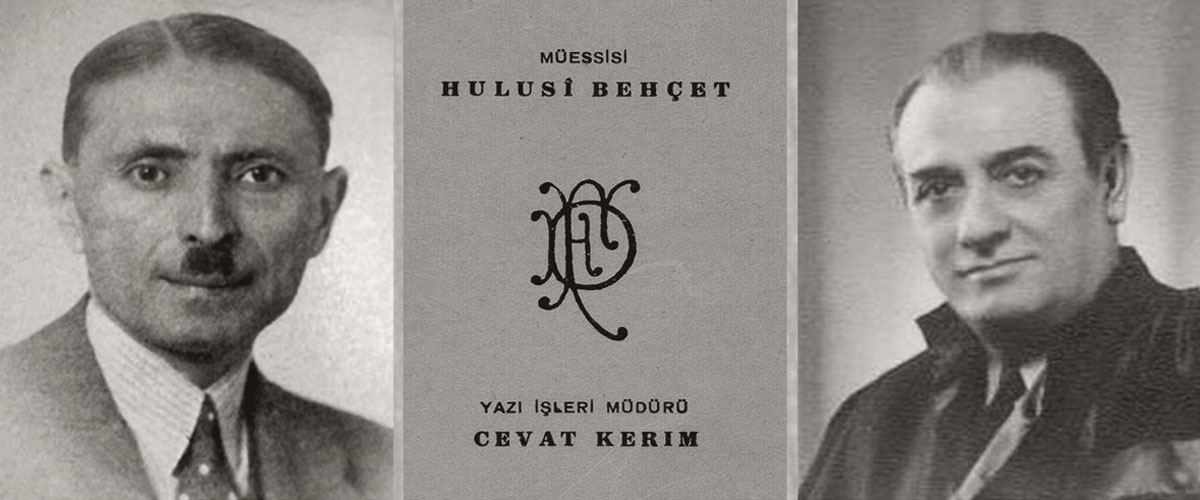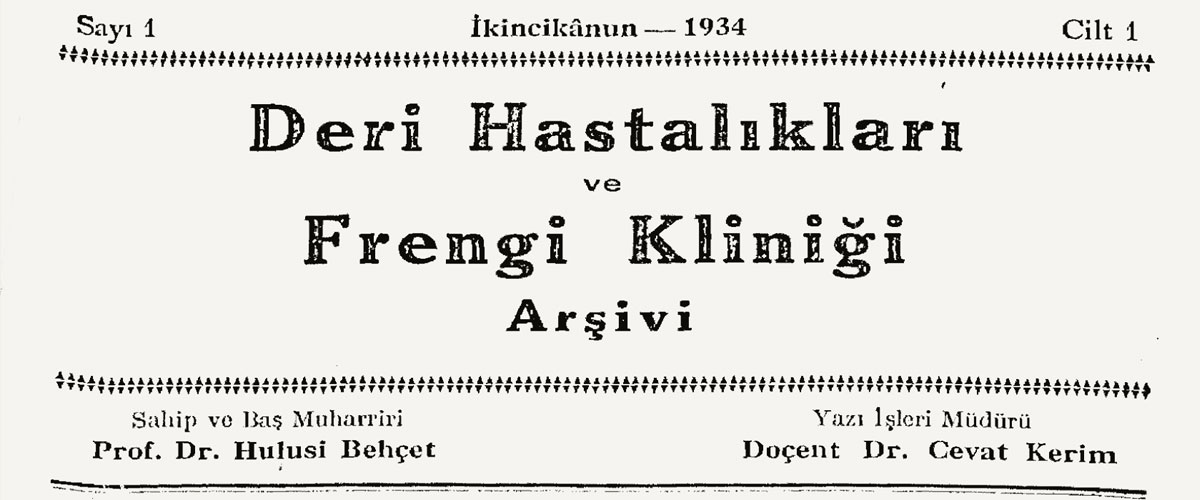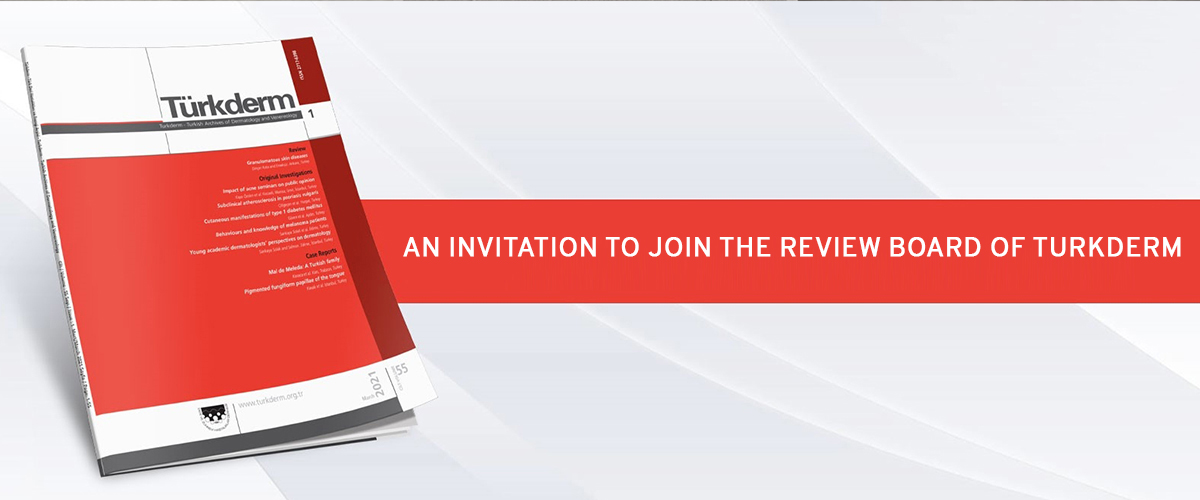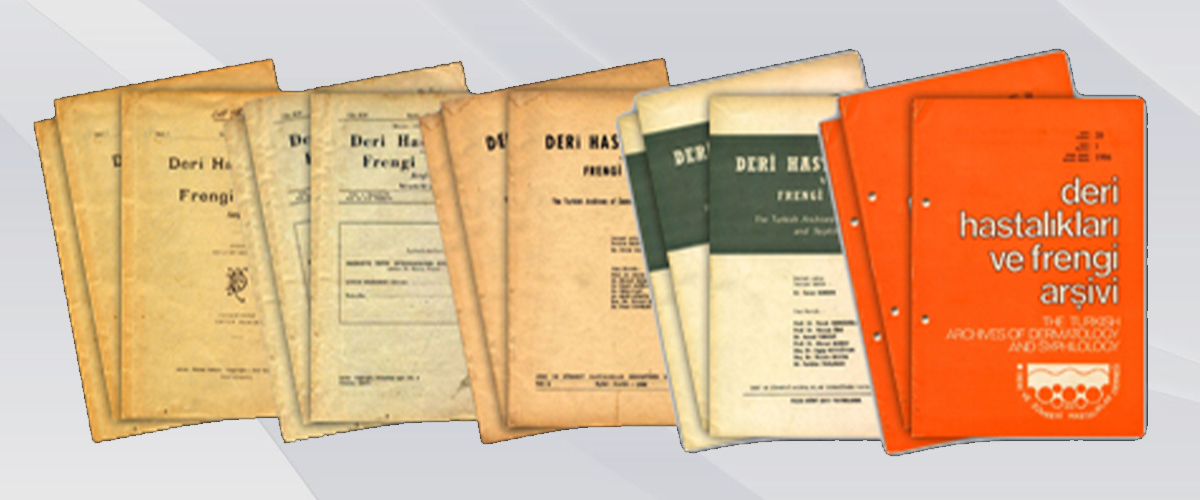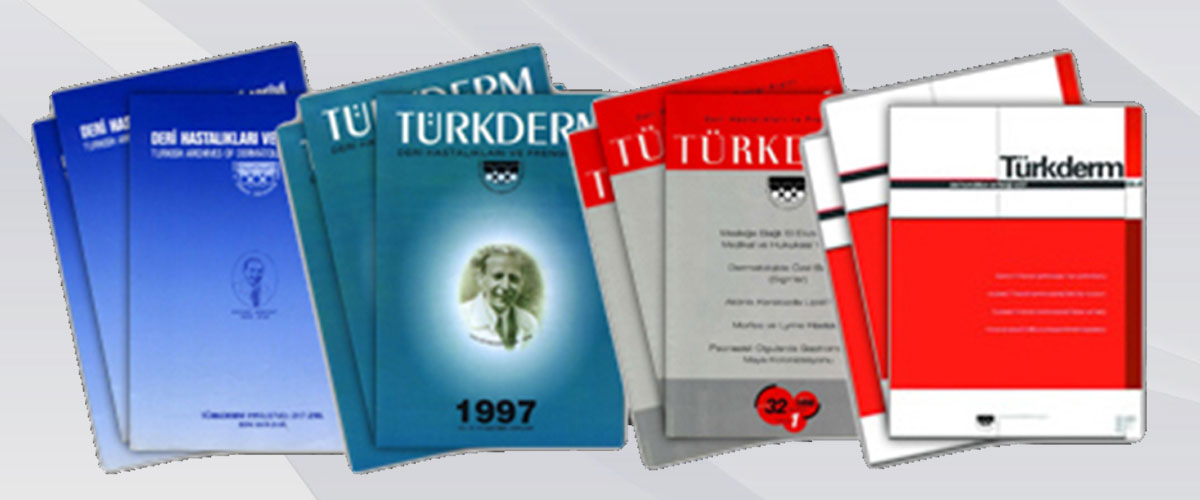Instruction for Authors
1. The Turkderm-Turkish Archives of Dermatology and Venereology (Formerly Turkderm-Archives of the Turkish Dermatology and Venereology) journal is published by the Society of Dermatology and Venereology in four issues (March, June, September and December with two supplement issues in June and December) each year. Turkderm is an independent international periodical journal based on double-blind peer-review principle.Articles in Turkish or English are both accepted for publication in print with the understanding that an English version is provided for the online publication prior to the final acceptance of the article. A Turkish version is not requested for articles submitted in English.
Turkderm does not charge any article submission or processing charges.
2. Aim of the journal: The journal issues include original reports of research in dermatology, case reports, invited reviews, abstracts, literature reviews, news, biographies and articles on medical history.
3. The journal publishes articles both in Turkish and English.
4. The journal should be abbreviated as "Turkderm - Turk Arch Dermatol Venereol" when referenced.
5. The editors and the editorial board of the journal have the authority to decide not to publish articles, return it to the author for correction or make corrections on format, according to the reports of the reviewers of the publishing consultant board.
A manuscript will be considered only with the understanding that it is an original contribution that has not been published elsewhere.
6. The manuscripts format should be in accordance with Uniform Requirements for Manuscripts Submitted to Biomedical Journals: Writing and Editing for Biomedical Publication (available at http://www.icmje.org/)
7. The scientific and ethical liability of the manuscripts and the copyright of the manuscripts belongs to the authors. Authors are responsible for the contents of the manuscript and accuracy of the references. All manuscripts submitted for publication must be accompanied by the Copyright Agreement Form (copyright agreement). Once this form, signed by all the authors, has been submitted, it is understood that neither the manuscript nor the data it contains have been submitted elsewhere or previously published and authors declare the statement of scientific contributions and responsibilities of all authors. Copyright Agreement Form should be submitted during the online manuscript submission process. The authors agree to transfer the commercial rights to Turkderm-Turkish Archives of Dermatology and Venereology if the article is accepted for publication.
7.1. All authors are required to individually complete and submit forms declaring their scientific contributions and responsibilities as well as the absence of any conflicts of interest. Any financial or in-kind support provided to the research, even if only partial, must be disclosed in a footnote, including the names of the relevant institutions, organizations, or pharmaceutical and material companies.
7.2. For the experimental, clinical and drug studies having the obligation of being approved by ethical committee and being sent in order to be published in the Turkderm-Turkish Archives of Dermatology and Venereology journal, ethical committee approval report being in accordance with the international agreements with Helsinki Declaration revised 2013 is required (https://www.wma.net/policies-post/wma-declaration-of-helsinki-ethical-principles-for-medical-research-involving-human-subjects/). In experimental animal studies, the authors should indicate that the procedures followed were in accordance with animal rights (Guide for the care and use of laboratory animals. www.nap.edu/catalog/5140.html) and they should obtain animal ethics committee approval. In articles concerning experimental research on humans, detailed description of procedures conducted should be included and patient/volunteer informed consent forms should be obtained. Informed consent forms are also necessary for case reports and they should be sent to the journal along with the article. Ethical committee approval (including approval number) and the informed consent given by the patients should be indicated in the Methods section. Authors should declare any conflict of interest concerning their articles and any financial support.
7.3. The author must obtain written permission from the copyright holders for pictures, figures, graphics, and tables and indicate this within the text.
7.4. A Scientific Ethical Board report is required for pharmacological studies.
8. Manuscripts are screened for plagiarism using the iThenticate software before publication.
9. The Editorial Policies and General Guidelines for manuscript preparation specified below are based on Recommendations for the Conduct, Reporting, Editing, and Publication of Scholarly Work in Medical Journals (ICMJE Recommendations) by the International Committee of Medical Journal Editors (2017, archived at http://www.icmje.org/). For manuscripts submitted to the journal, all authors are required to complete the ICMJE Conflict of Interest Disclosure Form.
9.1. Preparation of research articles, systematic reviews and meta-analyses must comply with study design guidelines:
9.2. CONSORT statement for randomized controlled trials (Moher D, Schultz KF, Altman D, for the CONSORT Group. The CONSORT statement revised recommendations for improving the quality of reports of parallel group randomized trials. JAMA 2001; 285: 1987-91) (http://www.consort-statement.org/);
9.3. PRISMA statement of preferred reporting items for systematic reviews and meta-analyses (Moher D, Liberati A, Tetzlaff J, Altman DG, The PRISMA Group. Preferred Reporting Items for Systematic Reviews and Meta-Analyses: The PRISMA Statement. PLoS Med 2009; 6(7): e1000097.) (http://www.prisma-statement.org/);
9.4. STARD checklist for the reporting of studies of diagnostic accuracy (Bossuyt PM, Reitsma JB, Bruns DE, Gatsonis CA, Glasziou PP, Irwig LM, et al., for the STARD Group. Towards complete and accurate reporting of studies of diagnostic accuracy: the STARD initiative. Ann Intern Med 2003;138:40-4.) (http://www.stard-statement.org/);
9.5. STROBE statement, a checklist of items that should be included in reports of observational studies (http://www.strobe-statement.org/);
9.6. MOOSE guidelines for meta-analysis and systemic reviews of observational studies (Stroup DF, Berlin JA, Morton SC, et al. Meta-analysis of observational studies in epidemiology: a proposal for reporting Meta-analysis of observational Studies in Epidemiology (MOOSE) group. JAMA 2000; 283: 2008-12).
10. General Guidelines
10.1. Manuscripts can only be submitted electronically through the Journal Agent website (http://www.journalagent.com/turkderm/?plng=eng/) after creating an account. This system allows online submission and review. You may track your article online. The manuscripts are archived according to ICMJE, Index Medicus (Medline/PubMed) and Ulakbim-Turkish Medicine Index Rules.
The ORCID (Open Researcher and Contributor ID) number of the correspondence author should be provided while sending the manuscript. A free registration can be done at http://orcid.org.
10.2. The titles of the articles should be brief and clear, consisting of a maximum eight words, not including conjunction words. Keywords in English and Turkish should be provided on the left upper part of the page above the title to facilitate indexing.
10.3. Author information should be entered to the system only while registering the summary. The electronic files to be uploaded to the system (full text, references, etc.) should in no way include the name and surname of the author.
10.4. For all types of manuscripts, a separate title page is required and should be submitted along with the manuscript. The title page will not undergo peer review and should include the following details:
- Title of the paper
- Keywords (minimum of 3)
- Word count, table count, and figure count
- Short running title
- Names and affiliations of all authors
- Corresponding author details (name, address, telephone, email)
- Funding sources
- Disclosure of conflicts of interest
- Acknowledgements
- Institutional ethics approval
- Statement of Informed patient consent, if applicable
- Data availability statement
11. Manuscript Types
11.1. Original Article
Includes clinical research, clinical observation, new methods, and experimental and laboratory studies. Research articles should include title, abstract, keywords related with main topic of the study, findings, discussion, acknowledgements, references, tables, graphs, and pictures. Title, abstract, and keywords should be both in Turkish and English.
11.2. Abstract: A summary of the manuscript should be written in both Turkish and English and not exceed 300 words. References should not be cited in the abstract. Use of abbreviations should be avoided as much as possible; if any abbreviations are used, they must be taken into consideration independently of the abbreviations used in the text.
The abstracts in English should include the following paragraphs: Background and design, material(s) and method(s), result(s), conclusion.
11.3. For original articles, the structured abstract should include the following sub-headings:
Objectives: The aim of the study should be clearly stated.
Materials and Methods: The study and standard criteria used should be defined; it should also be indicated whether the study is randomized or not, whether it is retrospective or prospective, and the statistical methods applied should be indicated, if applicable.
Results: The detailed results of the study should be given and the statistical significance level should be indicated.
Conclusion: Should summarize the results of the study, the clinical applicability of the results should be defined, and the favorable and unfavorable aspects should be declared.
Keywords: A list of minimum 3, but no more than 5 keywords must follow the abstract. Key words in English should be consistent with “Medical Subject Headings (MESH) (www.nlm.nih.gov/mesh/MBrowser.html). Turkish keywords should be direct translations of the terms in MESH.
11.4. Original research articles should have the following sections:
Introduction: Should consist of a brief explanation of the topic and indicate the objective of the study, supported by information from the literature.
Materials and Methods: The study plan should be clearly described, indicating whether the study is randomized or not, whether it is retrospective or prospective, the number of trials, the characteristics, and the statistical methods used.
Results: The results of the study should be stated, with tables/figures given in numerical order; the results should be evaluated according to the statistical analysis methods applied. See General Guidelines for details about the preparation of visual material.
Discussion: The study results should be discussed in terms of their favorable and unfavorable aspects and they should be compared with the literature. The conclusion of the study should be highlighted.
Study Limitations: Limitations of the study should be discussed. In addition, an evaluation of the implications of the obtained findings/results for future research should be outlined.
Conclusion: The conclusion of the study should be highlighted.
Acknowledgements: Any technical or financial support or editorial contributions (statistical analysis, English/Turkish evaluation) towards the study should appear at the end of the article.
References: Authors are responsible for the accuracy of the references. See General Guidelines for details about the usage and formatting required.
11.5. Case Reports
Case reports should present cases which are rarely seen, feature novelty in diagnosis and treatment, and contribute to our current knowledge. The first page should include the title in Turkish and English, an unstructured summary not exceeding 150 words, and key words. The main text should consist of introduction, case report, discussion and references. The entire text should not exceed 5 pages (A4, formatted as specified above).
11.6. Letter to the Editor
Letters to the Editor should be concise manuscripts prepared with the aim of providing critique or contributions to articles previously published in the journal. These manuscripts should not exceed 750 words, must not include an abstract, and should be limited to a maximum of 10 references and 6 authors. Short case reports may also be considered for publication under this section. In addition, Research Letters are evaluated under the same heading. Research Letters are concise reports of original research that highlight new findings or observations in a specific field. They should not include supplementary material or subsections, and may contain up to 2 tables or figures. Abstracts or keywords are not required, and these manuscripts do not need to be structured into separate sections. The primary purpose of this section is to provide a rapid and concise presentation of new research that will be of interest to the journals readership.
11.7. “What is your diagnosis?” reports should include a short introduction, followed by a definition of the problem, reports of pictures and figures that constitute hints, the definite diagnosis and a very brief discussion.
11.8. Review
Review articles are written to summarize the current state of understanding on a topic in the field of dermatology and venereology with an unbiased and comprehensive perspective. Reviews to be considered for publication should be written by authors having previously published manuscripts in the peer reviewed journals and proving their qualified expertise in the area. Authors considering the submission of a review article should contact the editors in advance to determine if the topic is of interest to the journal.
12. Tables, Graphics, Figures, and Images
All visual materials together with their legends should be located on separate pages that follow the main text.
12.1. Images
Images (pictures) should be numbered and include a brief title. Permission to reproduce pictures that were published elsewhere must be included. All pictures should be of the highest quality possible, in JPEG format, and at a minimum resolution of 300 dpi.
12.2. Tables, Graphics, Figures
All tables, graphics or figures should be enumerated according to their sequence within the text and a brief descriptive caption should be written in Arabic numbers. Any abbreviations used should be defined in the accompanying legend. Tables in particular should be explanatory and facilitate readers’ understanding of the manuscript, and should not repeat data presented in the main text.
The number of tables should not exceed three, and the number of lines should
not exceed 10 lines excluding the heading. They should only include
horizontal lines; no vertical lines should be included.
13. References
Authors are solely responsible for the accuracy of all references.
In-text citations: References should be indicated as a superscript immediately before the period/full stop of the relevant sentence. If the author(s) of a reference is/are indicated at the beginning of the sentence, this reference should be written as a superscript immediately after the author's name. If relevant research has been conducted in Turkey or by Turkish investigators, these studies should be given priority while citing the literature.
Presentations presented in congresses, unpublished manuscripts, theses, Internet addresses, and personal interviews or experiences should not be indicated as references. If such references are used, they should be indicated in parentheses at the end of the relevant sentence in the text, without reference number and written in full, in order to clarify their nature.
References section: References should be numbered consecutively in the order in which they are first mentioned in the text. When there are more than six authors in the tag of the article which is shown as a reference, the first three names should be written and then ve ark. and et al. terms should be used in Turkish and English references respectively. The titles of journals should be abbreviated according to the style used in the Index Medicus.
The following format should be especially taken into account for references:
13.1 Journals:
1) Initials of the surname and name of the author (colon);
2) Title of the article (only the first letter should be capital) (dot);
3) Abbreviation of the title of the journal in Index Medicus;
4) Date of publishing (semi-colon); Volume number (arabic) (colon); first page (hyphen) last page (dot).
Ex: 1. Akman A, Alpsoy E: Behcet's disease: current aspects in the etiopathogenesis. Turkderm-Turk Arch Dermatol Venereol. 2009;43:32-8.
13.2. Books:
a) If the whole book is written by the same author(s):
1) Name of the author (as in journal) (colon);
2) Title of the book (dot);
3) (If any) Edition (dot);
4) Publishing city, (Only the first, if more than one) (comma);
5) Publishing house (comma);
6) Date of publishing (semi-colon);
7) First page (hyphen) last page (dot).
Ex: 1. Lever WF, Schaumburg-Lever G: Histopathology of the skin. 6th Edition. Philadelphia. JB Lippincott Company, 1983;271-89.
13.3. Book Section:
b) If the editor and author of the chapter are different:
1) Name of the author (as in journal) (colon);
2) Title of the chapter (as in journal) (dot);
3) Title of the book (dot);
4) (Following e book (dot);) of editor(s) (dot);
5) (If any) Edition (dot);
6) Publishing city (comma);
7) Publishing house (comma);
8) Year of publishing (semi-colon);
9) First page (hyphen) last page of the chapter used (dot).
Ex: 1. Oke N: Deri hakkinda genel bilgiler. Dermatoloji. Ed. Tüzün Y, Kotogyan A, Saylan T. Istanbul, Nobel Tip Kitabevi, 1985;1-13.
14. The article will be sent back to its author immediately if these conditions are not met.


